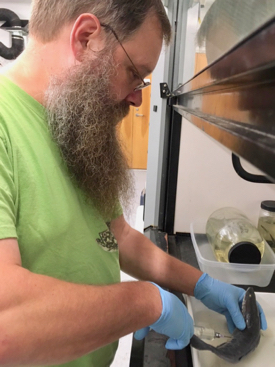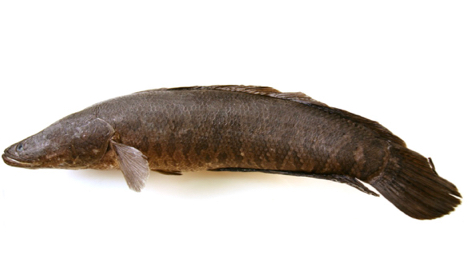VIMS adds first James-drainage snakehead to Fish Collection
Researchers use specimens of non-native fish to help track invasion
A northern snakehead—the non-native fish whose 2004 appearance along the Potomac River watershed unleashed a wave of public concern—has for the first time been found within the James River drainage in Virginia. The James is Virginia’s largest Chesapeake Bay tributary.
 The fish was collected on April 27th from Lakeview Reservoir near Petersburg by biologists with the Virginia Department of Game and Inland Fisheries. It has now been deposited in the Virginia Institute of Marine Science’s Nunnally Ichthyology Collection, where it joins two other snakehead specimens.
The fish was collected on April 27th from Lakeview Reservoir near Petersburg by biologists with the Virginia Department of Game and Inland Fisheries. It has now been deposited in the Virginia Institute of Marine Science’s Nunnally Ichthyology Collection, where it joins two other snakehead specimens.
“We now have three wild-caught specimens of Channa argus in the collection,” says Curatorial Associate Dr. Sarah Huber, “the one we just got from the James River drainage, one from the Potomac River drainage where the fish made its first Virginia appearance, and another from Chesapeake Bay near the mouth of the Little Wicomico River.”
The species is now established throughout the lower Potomac River watershed, and has been observed in the lower reaches of several other Maryland rivers as well as the lower stretches of the Susquehanna and Delaware rivers.
VIMS Associate Professor Eric Hilton, Curator of Fishes for the Nunnally Ichthyology Collection, says it’s likely that snakeheads could spread within the James River watershed once introduced. “Lakeview Reservoir is on Swift Creek, a tributary of the Appomattox. It can easily spread from there to at least the freshwater portions of the James River itself,” says Hilton.
A broader expansion is less probable, but not impossible. “Snakeheads are restricted to some degree by not being able to live in full strength sea water—or even the mainstem of the Bay,” says Hilton. “But it’s possible they can get from the mouth of one tributary to another along the Bay shoreline.”
The northern snakehead is a native of China that scientists believe was most likely introduced to the Bay watershed by release of a live fish purchased from an Asian food market. Hobbyists may also have released fish that had outgrown their aquarium tanks. Prior to being listed as “injurious wildlife” under the Lacey Act in 2002, snakeheads were sold in fish markets, restaurants, and pet stores in several major U.S. cities.
In 2005, Virginia’s General Assembly made possession of live snakeheads illegal, based on concerns about the fish’s potential to disrupt aquatic ecosystems and economies. Although some of the initial worries about the snakehead’s impacts on the Potomac River ecosystem now seem overstated—it appears to be co-existing with species like largemouth bass (themselves introduced) and is the target of a popular recreational fishery—concerns about the species remain.
“The most immediate concern,” says Hilton, “is, as an introduced, relatively large, predatory fish, snakeheads have the potential to out-compete native predatory fishes that fill a similar ecological role, such as bowfins and pickerel. They can also impact the abundance of prey species that have not evolved with snakeheads as a predator.”
Snakeheads can grow up to 3 feet long, and the world record for largest snakehead now comes from Virginia—a 17-pound, 6-ounce specimen caught in Aquia Creek, a tributary of the Potomac River, in 2013.
Hilton says the impact of a snakehead expansion in the James River watershed is hard to predict. “In some places in the Potomac drainage,” he notes, “the Department of Game and Inland Fisheries has found that the snakehead population has stabilized, or even declined a little, after their initial introduction and expansion.”
“However,” he adds, “even if the population stays small, introducing another non-native predator is not good for the overall health of the system.”
 Documenting the specimen
Documenting the specimen
Adding the Lakeview snakehead specimen to the VIMS fish collection is an important part of the scientific and management response.
“As with any specimen,” says Hilton, “this one is a unique, irreplaceable object—physical evidence of a particular species being found at a particular place and a particular time. In the case of invasive species such as snakeheads, this specimen documents for future researchers the timing of the ‘arrival’ of the species to the James River drainage.”
He says the preserved fish will also be used to train and educate biologists and the public on how to identify snakeheads, and to differentiate them from the similar, but native, bowfin.
“We also took a genetic sample of this specimen,” adds Hilton, “so that it can be used by future researchers to investigate the DNA from this population.”


